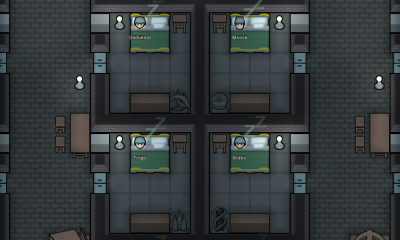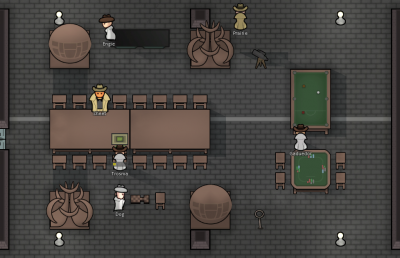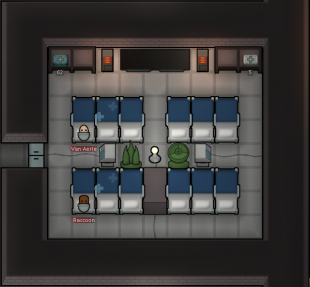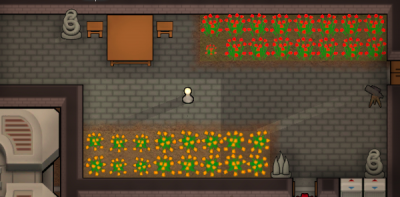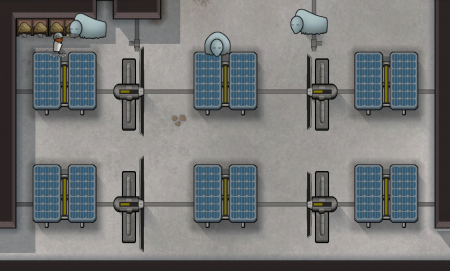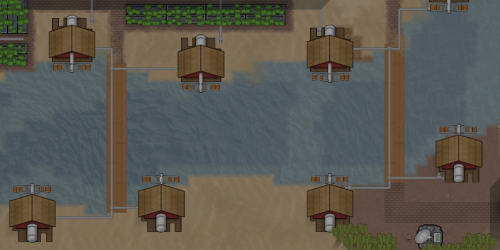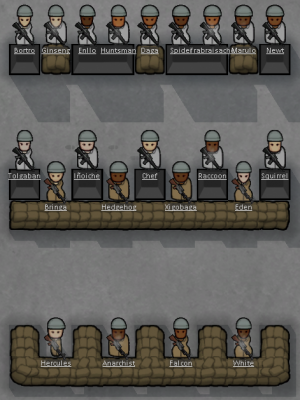Difference between revisions of "Colony Building Guide"
(table removed because it was messing up the design on mobile, pictures re-added) |
|||
| Line 1: | Line 1: | ||
{{TOCright}} | {{TOCright}} | ||
| − | |||
This guide is the ultimate go-to guide to building your base, for all stages of the game. | This guide is the ultimate go-to guide to building your base, for all stages of the game. | ||
Revision as of 19:57, 27 December 2018
This guide is the ultimate go-to guide to building your base, for all stages of the game.
Base Types
There are different ways to build your base. In all different designs one can opt to either predefine each room role or make modular rooms which are easier to expand but also less efficient.
Superstructure base
A superstructure base is a base where everything or almost everything is in one large building rather than smaller separate parts.
This is the most common method to build bases.
Pros
- Saves building materials and space.
- Easier to control temperature.
- Easier to defend against raids.
- More resistant against toxic fallout.
Cons
- Geothermal vents and patches of deep water can limit the design and patches of soft sand will require moisture pumps before building, marshy terrain can just be covered with bridges.
- Some areas might need to be unroofed to prevent cabin fever.
- Some large hallways might be needed to help defend against raiders dropping on top.
Separate structures base
Build everything in separated buildings, just like building a small town.
It is easier for starting off, but it is overall more vulnerable, so usually does not scale as well into late game.
Pros
- Easier to avoid areas with building restrictions.
- Naturally gets rid of cabin fever.
- Naturally offer areas in between buildings to fight raiders that drop on top.
Cons
- Requires more space and building materials overall.
- Harder to control temperature.
- Harder to defend against most raids.
- Vulnerable to toxic fallout.
Mountain base
For mountainous maps where you have less space to build, you can opt to dig inside the mountains instead.
Also very easy to start off, used to be the most popular kind of base but now depending on how bad the Infestations are it can be good or impossible late game.
Pros
- Saves a lot of building materials.
- Easier to control temperature.
- Easier to defend against raids.
- More resistant against toxic fallout.
- Free, beautiful floor and walls.
- Immune to sieges and raiders dropping on top.
Cons
- Infestations inside can be impossible to deal with.
- Cabin fever can be a real problem.
Base Structures
Different structures suit the different needs of your colony. Most maps generate with ruins around, sometimes just walls and others are squares/rectangles just missing some filling sections. These if conveniently located can work perfectly at starting points reducing considerably the initial workload of characters with low level skills and reducing the beginning stage stress when you still have nothing.
Warehouse
The warehouse is a room with a stockpile. The first room we need to build due to the "outdoors" deterioration on items if left in the open. It is not an official room role.
Later in the game the warehouse is usually the biggest room in the base. It should be covered by orbital trade beacons so you can sell your stuff to trade ships.
The electric crematorium and electric smelter may be placed here, if you store corpses, tainted clothes, useless guns and steel slag chunks inside, to speed up burning/melting them. Also, if you making chemfuel with wood you may place the biofuel refinery here.
It does not need to be impressive or temperature controlled and should be built close to the workshop to minimize travel times.
Bedrooms
Bedrooms are rooms with only one bed.
Only couples like to share a room, and all sleeping colonists will get disturbed by non-lovers walking about in the same room while they sleep, so once you have the resources you should upgrade to individual bedrooms for each colonist or couple. Couples will sleep together on double beds, but it is recommended to have double beds in all rooms since they have better impressiveness.
Good bedrooms give good mood modifiers so they should have plenty of art, good flooring and high-quality furniture. It should be temperature controlled for better moods. Dressers and end tables are recommended in bedrooms to increase the comfort of the bed. Royal beds are particularly good to have in bedrooms if you can afford it.
Colonists like to eat as soon as they wake up, but do not place table and chairs inside the bedrooms or colonists will use other colonists tables at night and cause 'Disturbed sleep' penalties, instead bedrooms should be built close to dining rooms. Still, some people choose to build table and chairs inside for aesthetics reasons.
Barracks
The barracks is a room with multiple beds.
They are usually a good option early-game when resources are limited, or during late-game to deal with an overflow of people. Overall, it is better to have separate bedrooms since barracks give a lower mood modifier and cause a lot of 'Disturbed sleep' penalties.
Good barracks give good mood modifiers so they should have plenty of art, good flooring and high-quality furniture. It should be temperature controlled for better moods. Dressers are a very good addition to barracks since they increase the comfort of many beds at once.
Colonists like to eat as soon as they wake up, but do not place table and chairs inside the barracks or colonists will use the tables at night and cause 'Disturbed sleep' penalties, instead barracks should be built close to dining rooms.
Dining room
Dining rooms are rooms with table and chairs for colonists to eat in.
It is usually a good idea to have the main dining room near the food storage so your colonists will actually use the dining room, instead of eating on the floor. It is also a good idea to have minor dining rooms near the colonists bedrooms or they might eat their breakfast on the floor since colonists tend to go to bed with food and eat as soon as they wake up.
In big bases, dining rooms can be partially unroofed to get rid of cabin fever since colonists do not mind eating in hot or cold rooms.
Good dining rooms give good mood modifiers so they should have plenty of art, light, good flooring and high-quality furniture. It does not need to be temperature controlled. Nutrient paste dispensers are very useful on dining rooms to ensure that nobody needs to eat raw food, they are usually placed half in the dining room and half in the freezer.
Dining rooms can be combined with recreation rooms.
Recreation room
The recreation room is a room with sources of joy.
Colonists get bored of using the same joy source repeatedly, so you should have as many joy sources as possible in the recreation room.
In the early game, all you need is a horseshoes pin and a chess table. During mid-game you can add a poker table, a billiards table and a tube television, then upgrade it to a flatscreen television. Later, buy a megascreen television and a telescope from traders.
In big bases, recreation rooms can be partially unroofed to get rid of cabin fever since colonists do not mind playing in hot or cold rooms.
Good recreations rooms give good mood modifiers so they should have plenty of art, light, good flooring and high-quality furniture. It does not need to be temperature controlled.
Recreation rooms can be combined with dining rooms.
Freezer
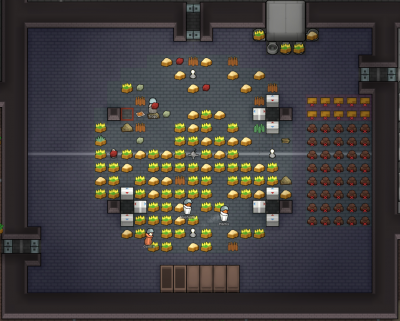
The freezer is room with a stockpile that is kept cold by coolers. It is not a official room role.
The freezer is a room with coolers to keep your perishables that would otherwise spoil in the storage like food and corpses. Because you will be storing your harvests here, it is wise to position this room close to your plantations to reduce hauling jobs, with the doors pointing toward your growing zones. It should be covered by orbital trade beacons so you can sell your food to trade ships.
This is usually the second biggest room in the base. Nutrient paste dispensers are usually placed half in the dining room and half in the freezer.
Even though food freezes at 0 °C (32 °F) you should have your freezer at least set at -5 °C (23 °F) since it will lose temperature whenever a colonist comes in. It is common to make airlocks in the entrance of the freezer to reduce that temperature exchange. It is also common to make the freezer with double walls to increase insulation. The freezer is vulnerable to solar flares.
To save power it is a good idea to have the coolers set to different temperatures. For example, if two coolers are set to -5 °C (23 °F) then both will always consume power, but if a cooler is set to -5 °C (23 °F) and another is set to -8 °C (17.6 °F) then the first will only consume power during hotter times when the second is not able to keep the temperature bellow -5 °C (23 °F) alone.
Coolers placement is of crucial importance as these devices have a very low HP, making them the weakest point in a wall from where raiders would break in easily and most likely ignite your food supply. Because of this, one of the best ways to keep your freezer away from harm is to place the coolers in the inside unroofed, or of course, wall off the coolers too.
Butcher spots, butcher tables and crafting spots can be placed inside the freezer to butcher corpses, make kibble and make smokeleaf joints, since the work to make those is so small and the ingredients are in the freezer your colonists might as well do it there. However, for mass production, it is better to have it close but outside the freezer due to the work speed penalty.
Nutrient paste dispensers are usually placed half in the dining room and half in the freezer.
It does not need to be impressive and should be built close to dining rooms and kitchens.
Kitchen
The kitchen is a room with a stove or a butcher table.
The kitchen is where your colonists turn raw food into meals. The room should be clean to avoid food poisoning, so the butcher table may be placed nearby in a different room instead since it creates a lot of filth.
Besides stoves, the kitchen should include chairs, light and sterile tiles. You might want to add a little vegetable stockpile inside to save travel time, as plants take awhile to spoil.
Since the kitchen is placed near the freezer, some crafting stations which include plants ingredients may be also placed in here. The brewery and drug lab are good choices and if you do place them here you should also add tool cabinets and little stockpiles for hops, smokeleaf leaves, psychoid leaves and neutroamine. Also, if you making chemfuel with food you may place the biofuel refinery here.
It does not need to be impressive, but it is usually a good idea to add a little art since colonists tend to stay there for a long time. It should be temperature controlled for better working speed.
Zone out colony animals.
Workshop
The workshop is a room with crafting stations.
The workshop is where your colonists turn raw materials into advanced products. Besides crafting stations, the workshop should include chairs, light and tool cabinets. A lot of different little materials stockpiles may be placed inside to save travel time.
Early game crafting stations include the stonecutter's table, sculptor's table, hand-tailoring bench and fueled smithy. Mid game crafting stations include the machining table, as well as the electric versions of hand-tailoring bench and fueled smithy. Late game crafting stations include the fabrication bench.
The brewery, drug lab, biofuel refinery, electric crematorium and electric smelter may also be placed here.
It does not need to be impressive, but it is usually a good idea to add a little art since colonists tend to stay there for a long time. It should be temperature controlled for better working speed.
It should be built close to storage.
Laboratory
The laboratory is a room with a simple research bench or a hi-tech research bench.
Research speed is affected by the cleanliness of the room which is why it might be worth making a separate room for it. It should be isolated to avoid other people walking in dirt.
Besides the research bench, the laboratory should include a chair, light and sterile tiles. After you get the hi-tech research bench you can also get a multi-analyzer.
It does not need to be impressive, but it is usually a good idea to add a little art since colonists tend to stay there for a long time. It should be temperature controlled for better working speed.
Zone out colony animals.
Hospital
The hospital is a room with a medical bed. It is a place specialized in treating your colonists. If you do not have one, colonists will be treated in bedrooms. The room should be clean to avoid infection.
In early-game all you need is floors, beds and a light source. During midgame you should replace your floor with sterile tiles and your beds with hospital beds, and add vitals monitors. All these will increase treatment quality.
Store medicine in or near your hospital so your doctors can quickly patch up your colonists.
Good hospitals give good mood modifiers so they should have plenty of art and high-quality furniture. It should be temperature controlled for better moods and to prevent heatstroke or hypothermia from visitors. Since injured colonists will likely spend a lot of time in the hospital it is a good idea to add televisions which they can watch while in bed. If you do not have televisions, other colonists will go to the hospital to cheer them up to provide joy.
It should be built close to the base entrance for quicker rescue.
Zone out colony animals.
Armory
The armory is a room with a stockpile for weapons and armor. It is not an official room role.
Often your colonists need to change their guns and gear to better fight different kinds of raids. Having an armory helps to keep your gun and gear stock under control and puts them in a more accessible position for your colonists to grab them quickly.
It does not need to be impressive. It does not need to be temperature controlled.
It should be built close to your defenses for quicker reaction to raids, and should also be far away from the prison.
Barn
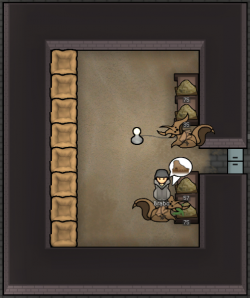
The barn is a walled area with animal sleeping spots, animal sleeping boxs or animal beds.
Barns help ensure that hauling animals will go back to your base at night for safety and that fragile animals will be isolated from predators. They are also used to ensure that animals products will drop near your base for quicker hauling.
They should include stockpiles of hay or kibble for the animals, if they are placed outside they should be in a shelf to avoid deteriorating. Since animals go back to their boxes or bed for healing it might be a good idea to store medicine near your barn for quicker patching up, again if placed outside they should be in a shelf.
Sometimes, it is good to have a small separated barn to bring in wild animals that you want to tame. Wild animals might go away or die for many different reasons, but if you keep them in an isolated room with food they will stay there forever. A good example is an animal herd passing through the area. You will not have time to tame them, but you can beat them down and bring them to your base and have all the time you need to tame them. Also prevents them from causing damage if the taming fails.
It does not need to be impressive, indeed it is better to not put down floors to avoid animal filth. It does not need to be indoors but you might want to at least partially roof it in case a toxic fallout happens. It does not need to be temperature controlled unless if your animals cannot handle the local temperature.
It can be combined with outdoors rooms, like your power supply area. It should be built close to freezer or warehouse.
Prison
The prisons is the place where you put your captives of war. Better prisons make it easier to recruit people. Still, they are not consistently used, so one should consider how much effort and resources should be invested in it. During mid-late game, prisoners without immediate use can be kept for free inside cryptosleep caskets instead.
Basic features:
- Enclosed by walls.
- Beds or sleeping spots.
- Safe temperature.
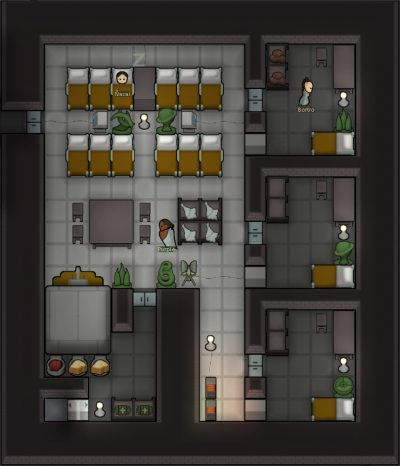
Good mood features:
- Light source.
- Floors.
- Table and chairs.
- Art.
- Comfortable temperature.
- Dressers and end tables.
- Psychic emanator.
Convenience features:
- Food stock.
- Medicine stock.
- Uniform stock.
- Nutrient paste dispenser.
Medical features:
Safety features:
- Isolated from the rest of the base, but not close to the map edges.
- Isolated from any potential weapons, even wood and beer.
- Doors connected to an empty walled area, possibly guarded by turrets.
Prisons can have the following rooms:
Prison barracks
Barracks are rooms with multiple prisoner beds.
They are cheaper than cells and allow for features that are unreasonable to have in every single cell. The barracks mood modifier is lower than the cell but the barracks usually provides the 'Spacious interior' modifier and better dining room modifier, so they arguably offer better mood than cells since prisoners do not get 'Disturbed sleep' penalties. However, if a prison break happens all prisoners in the same barracks will break out together.
Prison cells
Cells are rooms with a single prisoner bed.
Cells offer only slightly better mood improvement than barracks and usually are much more limited in what they can have. The major advantage of cells is that if a prison break happens, not all prisoners in nearby cells will join. They also prevent fights between prisoners.
If you are lacking space for prisoners, a colonist bedroom can be temporarily turned into a cell.
Prison hospital
The prison hospital is a room with medical prisoner beds. It is not an official room role.
Prisoners often first enter your prison injured, so having a proper prison hospital can help avoid unnecessary deaths and infections. They are like a regular hospital attached to the rest of your prison, however, you do not need to have televisions in it since prisoners are not affected by joy.
The prison hospital does not need to be a separated room only for healing. It can be the barracks but with medical features.
Prison freezer
The prison freezer is a room with a stockpile kept cold by coolers inside the prison. It is not an official room role.
For storing stocks of food and herbal medicine to prevent spoilage. If you have a Nutrient paste dispenser you can place half of it and all the hoppers inside.
Courtyard
You may consider building an unroofed courtyard in the center of your base where colonists can get some fresh air. It is not an official room role.
Functionally, the courtyard behaves exactly the same as a dinning/recreation room unroofed. You can use it as a common area, putting joy items and dining tables for colonists to use. It may be used as a place to put your mortars as putting them in the middle helps negate their blind spots, or transport pods. This is better if it is a separate unroofed area as they are not beautiful to look at.
Tomb
The tomb is a room with sarcophagi.
Not the most important of the rooms, but colonists do go visit sarcophagi or graves filled with dead colonists for joy so you might want to give a nicer room for them to do that.
It does not need to be impressive or temperature controlled and can be built anywhere.
Production
You will need fields, buildings and animals to provide the raw materials that your colony needs.
Crop fields
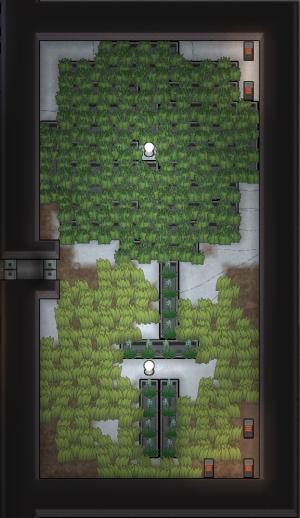
See also: Food production
Crop fields are growing zones or hydroponics basins, designated to the desired plant type.
Depending on the soil fertility different plants might generate the best productivity:
Crop fields do need to be protected from raiders or they will burn them down, which can be hard on harsh biomes where the fertile soil might be far away from your base; however, crop fields are not particularly important structures, so they need not be given priority in defense.
They also need to be protected from animals, both wild and domestic. Crop fields are vulnerable to blights and toxic fallout.
Ideally, they should be made near your freezer.
Greenhouses
Greenhouses are a protected version of crop fields. They are growing zones or hydroponics basins in a temperature controlled environment. Since they are indoors, they also require sun lamps.
They are much more expensive than fields but they allow crops to grow all year in cold environments. It is common to make airlocks in the entrance of the greenhouse to reduce temperature exchange and make it with double walls to increase insulation. They are vulnerable to blights and solar flares.
To save power it is a good idea to have the heaters set to different temperatures. For example, if two heaters are set to 21 °C (69.8 °F) then both will always consume power, but if a heater is set to 21 °C (69.8 °F) and another is set to 24 °C (75.2 °F) then the first will only consume power during colder times when the second is not able to keep the temperature above 21 °C (69.8 °F) alone.
Ideally, they should be made near your freezer.
Mines
Mines are areas your colonists go to mine.
If you are mining the stones in the outside layer of a mountain then you got nothing to worry about. However, if you decide to mine deep inside a mountain, then you need to build a proper mine as you mine out the stones to avoid rocks collapsing on top of your colonists. Wood is usually a good cheap material to use to make mines.
Another thing to worry about when making mines is infestations. You can build doors inside your mine to create choke points where you can fight the insects and help your colonists running away. Alternatively, you can fill up the whole mountain with wood so infestations can not happen at all.
Drilling rooms
Deep drills are often placed far away from your base and similar to mines that they can also cause infestations. So you might want to enclose the area with walls and doors to create choke points where you can fight the insects and prevent predators from attacking isolated miners.
Animals
Animals have a variety of uses, therefore herding some of them in your barn can be very helpful. Of course all animals can be used for different reasons, but it is worth mentioning some of them because they are either particularly useful or versatile:
- Produce raw food: eggs, milk or meat. Chicken, Cow, Dromedary, Muffalo, Pig.
- Produce textiles: leather or wool. Chinchilla, Alpaca, Dromedary, Muffalo, Megasloth.
- Produce fuel: chemfuel. Boomalope.
- Haul animals. Pig, Wild boar, Elephant, Megasloth.
- Pack animals. Alpaca, Dromedary, Muffalo, Elephant.
- Combat animals. Wild boar, Elephant, Megasloth.
Chicken, Cow, Chinchilla, Alpaca and Boomalope are quite profitable.
Pig, Wild boar, Elephant and Megasloth are the only ones that can graze and haul.
Dromedary, Muffalo, Elephant and Megasloth are really versatile.
One should notice that combat animals are much better at defending caravans than defending your base.
Power
Your colony needs power, so you should provide generators and protect them from attacks. Therefore, it is better to place them inside your base walls. Your options for power generation include the following.
Solar power
Solar generators provide power only during the day. It provides 1700W during summer peak hours near the equatorial line, but nothing at all in winter near the poles. They are particularly good to power up sun lamps since those only consume power during the day. They should be used together with batteries so you may still have power during the night. They are vulnerable to eclipses.
Wind power
Wind turbines provide unstable power throughout the day. It can provide up to 3000W, but it usually gives less than that. They should be used together with batteries to make up for the instability.
It requires plenty of open space for maximum efficiency and any obstacles can easily reduce efficiency. To prevent trees from growing and obstructing the turbines, you may grow crops underneath the turbines or fill in the gaps with solar generators.
Fueled generation
You can get the wood-fired generator which runs on wood, or the chemfuel powered generator which runs on chemfuel. Both provide a constant 1000W of power, so it is a good idea to have some of these as a backup power source, or even as your main source in biomes that are loaded with trees. Since they are stable they do not require batteries.
Chemfuel is significantly more efficient than wood, so once you research the biofuel refinery it is better to refine wood into chemfuel before using it as fuel.
They are useful complementing Solar generators during winter in cold biomes, since Solar generators does not work in winter near the pole.
Boomalope setup
3 Boomalopes generate enough chemfuel to run 4 generators. It is easy to run an entire base on that setup since they generate more energy than you spend to grow food for them, specially if your colony is somewhere they can graze.
Infinite chemreactor setup
Infinite chemreactors generate enough chemfuel to run a generator, which in turn generates more than enough power to run the chemreactor.
It is overall an amazing setup but infinite chemreactors are hard to come by, so you should not expect to run your whole base on that.
Geothermal power
Geothermal generators constantly gives 3600W of power after being built on a steam geyser.
While powerful, it has one big issue; you can not choose where the steam geysers will be, so if you do not have one inside your base you need to cover them with walls to protect them. If you wall off your geothermal generator completely with double walls the raiders will ignore it most of the time. They will, however, sometimes randomly attack your walls, but it is really unlikely that they will destroy both walls and reach the generator. As it can randomly break down, you should still add doors so colonists can enter, better to use stone doors because they are durable and raiders can not ignite it.
Another problem is that raiders will likely destroy the conduits connecting the generator to your base, so build multiple conduit lines to reduce the likelihood of raiders completely severing the connection. Also, even though they do not need batteries, you should build some in case it gets disconnected during a raid.
Note that they generate plenty of heat, so they should be unroofed or they will catch on fire.
Watermill generator
The watermill generator constantly provides 1100W of power but has to be placed next to rivers. So you must include the river inside your base design. However, that is usually quite simple since rivers tend to cross the whole map edge to edge. It does mean you will have to wall off a larger area, but it is well worth it since the watermill is quite reliable and lots of them can be placed on the same river.
It is quite easy to run a base just on watermills but of course, rivers are not available in every map. Since they are stable they do not require batteries.
Vanometric power cell
A vanometric power cell constantly provides 1000W of power and can be placed anywhere. Like the infinite chemreactor, they are hard to come by, so you should not expect to run your whole base on that.
They are particularly good for starting off new bases, or sometimes powering isolated objects such as deep drills.
Power storage
Batteries store surplus power. They are recommended for when you rely on power sources that are not constant, such as wind or solar power. They allow for power storage during times of excess to be used during times of demand. For instance, this makes them useful to store spare power generated during the night from fueled generators in order to supply sun lamps during the day.
Not having batteries is also beneficial, if you have reliable power sources, since it almost nullifies the short circuit event, igniting a little fire instead of causing a huge explosion.
Batteries need to be placed under a roof to prevent short-circuits during rain and should be placed indoors to protect them from external threats. Connect them to the grid via switches and shut off part of them after they are filled to reduce the impact of short circuits and have back up batteries in case of emergency.
Power network
It is not a good idea to have just one conduit spanning the entirety of your base. While it saves materials, short circuits or other events can create breaks that can disconnect entire parts of your base from power. Instead, build a network with redundant pathways so that the grid will continue to function even if there is a break.
Also, it is better to split the power network of your base. Having more than one power network makes power management harder but the short circuit event will be much smaller since it will not affect your whole base and all your power reserves.
Defenses
Unless you are playing on peaceful difficulty, you will eventually encounter major threats, so you will need to prepare your defenses for that.
More defensive buildings can be seen on defense structures. Here, we show only the basics.
Static cover
At the very least you must have some sources of cover in your base. This includes sandbags and sometimes walls. They are enough on early-mid game or on easier difficulties.
In a static cover based defense, it is better to combine two different types of cover structure, one using walls and another with sandbags covering the sides. The walled cover should be used where the enemy will engage, as the walls restrict the attack angle, and there should not be anyone standing behind the sandbags- these should be for soaking fire from oblique angles only. The other kind should be used at the sides to allow for a more flexible attack area.
The major problem of basic static cover is enemies with long-ranged weapons. They will have a lot of time to shoot at you while you are busy with the rest of the raid party. Raiders with triple rocket launcher and doomsday rocket launcher are particually dangerous if you rely on static cover since they are really long-ranged and only need one shoot to explode your defenses. For those reasons you might want to enclose your combat area into a killbox.
Killbox
A basic yet powerful defense setup is the killbox. It is a walled area full of traps and turrets where you fight your enemy, making sure they do not out-range you or have cover, while your colonists have plenty of cover. It only works if it is the only entrance to your base and your whole base is surrounded by double walls.
Turrets should all be connected to your power grid by power switches. Put them in front to distract enemies such that they go for them before your colonists. They should be switched off if a manhunter pack shows up, as it is better to let them die by your traps and finish them off by melee blocking them.
If a full-melee raid with shield belts or a scyther-only raid shows up, throw EMP grenades at them while they gather around your turrets as it will significantly weaken them. While they are occupied attacking the turrets, you can shoot them up, and if they manage to destroy all the turrets, prepare to finish the survivors by melee blocking them.
Centipedes with inferno cannons are one of the major counters of killboxes, since the fire makes your colonists lose control and run out of cover. They are the main reason why you should have walls and not only sandbags in your defense, their inferno cannons can shoot over sandbags but it can not shoot over walls, so a colonist behind a wall is less likely to catch on fire then a colonist behind a sandbag. Having some firefoam poppers inside your box helps a lot with extinguishing fires and preventing future fires. EMP grenades also weaken them a lot if you can get close enough to throw them.
Raiders with triple rocket launcher and doomsday rocket launcher are still a problem. If they manage to shoot inside your box the damage can be massive, but here they are in range of your colonists guns so you can focus them down before they do anything.
Some enemies do not run into your box, but can be lured into it, such as raiders from sieges or mechanoids guarding crashed ships. Snipers can safely poke them from far until they aggro and bring them to the box.
Killboxes do not protect against sappers and raiders dropping on top of you. For those, you will need another strategy.
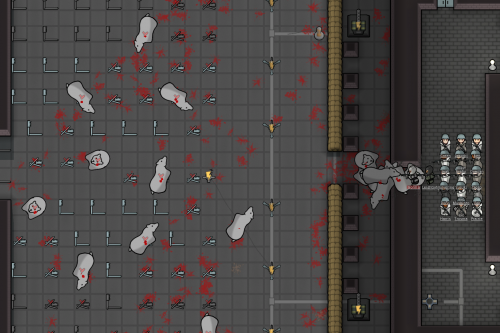
Temperature control
Some rooms should have its temperature regulated by some method or another, so as to keep a comfortable temperature for colonists to work and sleep in and protect them from extreme temperature conditions such as heat waves, cold snaps or simply the outdoor ambient temperature.
Larger rooms such as your kitchen and workshop should have their own heaters and coolers. If they are interconnected you may want to open doors for faster colonist access and temperature exchange.
Smaller rooms such as your bedrooms should be thermally connected to a larger central space through vents. Your heaters and coolers should be all placed outside the bedrooms. This reduces the number of heaters and coolers you need to build while keeping your bedrooms at a comfy temperature at the same time.
Keep in mind, that you will also need to be prepared in case of unusual temperature events, such as heat waves or cold snaps. Which, in severe cases, will cause heatstroke or hypothermia. Heat waves will also spoil your food and corpses.
Temporary temperature control
If your regular heaters or coolers are not enough or there is a temporary power outage or you are a tribe without the ability to harness electricity yet, you can use campfires or passive coolers to heat or cool down your base respectively. Both have the same effect as their electric variants, except that they need to be refueled and are limited in their available temperature range: campfires can not heat above 30°C while passive coolers can not cool below 15°C. Also, their temperature effect is full and cannot be controlled. Depending on what gear your colonists are wearing, it is possible for them in a room heated with campfires to complain about it being too hot.
These are best used to keep colonists comfortable during heat waves or cold snaps. If you always encounter uncomfortable temperatures during summer or winter then it is time to get more heaters or coolers.
Miscellaneous
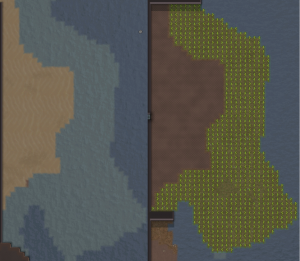
Do not rush flooring
Until you have enough manpower to spare for cleaning jobs, instead of building any floors, you can use the terrain as floors. Terrain does not generate animal and human filth and filth trailed on constructed floors makes for a much worse beauty penalty than using dirt floors, so this can actually make your rooms look better.
However, for places like hospitals, it is always better to use sterile tiles and manually clean them instead.
Flooring outside
To reduce the amount of dirt inside your colony buildings, put any kind of flooring covering places where colonists and animals frequently walk. This reduces the amount of dirt brought inside your base.
This should obviously be done only if you have enough janitors.
Moisture pumps
Moisture pumps clear out moisture from the ground around them, creating dry land suitable for construction and agriculture. They are excellent in swamp biomes for clearing out shallow water, marshy soil and mud in order to build structures. Their effect is permanent, so they can safely be deconstructed once the land you want to use is dry. Note that shallow water will be converted to stony soil, which only has 70% fertility. Still, this can be the only way to farm on the ground in biomes like Extreme Desert and Ice Sheet. Can not be used for farming in Sea Ice since it creates ice ground.
